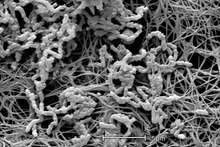Achromobacter xylosoxidans
| Achromobacter xylosoxidans | |
|---|---|
 | |
| Achromobacter xylosoxidans | |
| Scientific classification | |
| Kingdom: | Bacteria |
| Phylum: | Proteobacteria |
| Class: | Beta Proteobacteria |
| Order: | Burkholderiales |
| Family: | Alcaligenaceae |
| Genus: | Achromobacter |
| Species: | A. xylosoxidans |
| Binomial name | |
| Achromobacter xylosoxidans Yabuuchi and Yano 1981[1] | |
| Type strain | |
| ATCC 27061, BCRC 12839, CCM 2741, CCRC 12839, CCTM La 3521, CCUG 12689, CDC KC 1064, CDCKC1064, CECT 467, CECT 927, CGMCC 1.2007, CIP 71.32, DSM 10346, DSM 2402, DSMZ 10346, DSMZ 2402, EY 543, GIFL 543, GIFU 543, Hugh 2838, IAM 12684, IFO 15126, IMD 101001, JCM 9659, KACC 10205, KM 543, LMG 1863, NBRC 15126, NCIB 12033, NCIMB 12033, NCTC 1 O807, NCTC 10807, NRRL 84082, NRRL B-4082, NXRX 10807, PCM 2222, R-16924, R. Hugh 2838, R.Hugh 2838, RH 2838, RIMD 101001, strain KM 543, strain Takeda, VTT E-991282 Yabuuchi KM 543[2] | |
Achromobacter xylosoxidans (formerly Alcaligenes xylosoxidans) is a Gram-negative, aerobic, oxidase- and catalase-positive, motile bacterium with peritrichous flagella, from the genus Achromobacter. It is generally found in wet environments. Achromobacter xylosoxidans can cause infections such as bacteremia,[3][4] especially for patients who suffer from cystic fibrosis (CF).[5] In 2013, the complete genome of an A. xylosoxidans isolate from a CF patient was sequenced.[6]
Pathogenesis
Originally isolated from patients with otitis media,[7] A. xylosoxidans has since been periodically described as a pathogen of humans.[8] Infection is frequently associated with hospital stay,[8] as well as CF.[5]
See also
References
- ↑ "Genus Achromobacter". LPSN. Retrieved 11 November 2015.
- ↑ "Taxon Passport: Achromobacter xylosoxidans". StrainInfo. Retrieved 11 November 2015.
- ↑ Y Igra-Siegman; H Chmel; C Cobbs (1980). "Clinical and Laboratory Characteristics of Achromobacter xylosoxidans Infection". J Clin Microbiol 11 (2): 141-145. PMC 273340. Retrieved 11 November 2015.
- ↑ JM Duggan; SJ Goldstein; CE Chenoweth; CA Kauffman; SF Bradley (Sep 1996). "Achromobacter xylosoxidans bacteremia: report of four cases and review of the literature". Clin Infect Dis 23 (3): 569-576. PMID 8879782. Retrieved 11 November 2015.
- 1 2 "Achromobacter xylosoxidans". Cystic Fibrosis Medicine. Retrieved 11 November 2015.
- ↑ Jakobsen TH; Hansen MA; Jensen PØ; Hansen L; Riber L; et al. (22 July 2013). "Complete Genome Sequence of the Cystic Fibrosis Pathogen Achromobacter xylosoxidans NH44784-1996 Complies with Important Pathogenic Phenotypes". PLoS ONE. e68484. doi:10.1371/journal.pone.0068484.
- ↑ E Yabuuchi; A Ohyama (1971). "Achromobacter xylosoxidans n. sp. from Human Ear Discharge". Japan J Microbiol 15 (5): 477-481. PMID 5316576. Retrieved 12 November 2015.
- 1 2 J Gomez-Cerezo; I Suarez; J J Rios; P Pena; MJ Garcia de Miguel; et al. (16 May 2003). "Achromobacter xylosoxidans Bacteremia: A 10-Year Analysis of 54 Cases". Eur J Clin Microbiol Infect Dis 22 (6): 360–363. PMID 12750959. Retrieved 12 November 2015.
External Links
This article is issued from Wikipedia - version of the Saturday, February 06, 2016. The text is available under the Creative Commons Attribution/Share Alike but additional terms may apply for the media files.